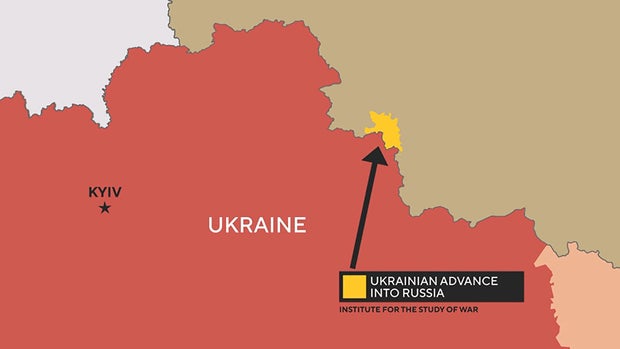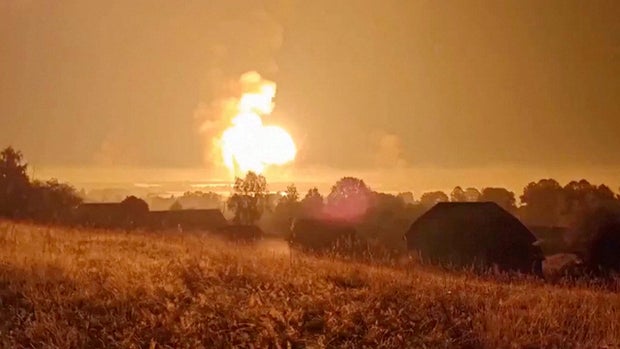The stakes behind Ukraine's surprise attack inside Russian territory
Ukraine's surprise thrust into Russia – armored columns slicing through unprepared defenses, seizing towns and settlements – is perhaps the most audacious gamble in more than two years of war, since the invasion was launched by Russian President Vladimir Putin. "There's a big psychological blow here to the Russian mindset, specifically Putin, where you have a Ukrainian penetration of Russian territory, [for the] first time since World War II," said former Joint Chiefs Chairman Mark Milley.
But Milley points out the 500-square-mile bulge is barely a dot on the map of Russia. And with three exposed flanks, it comes with considerable risk. "The Russians could mass forces, cut them off and overrun the Ukrainians," Milley said.

Asked if he expects Putin to launch a major counter-offensive to take back Russian territory, Milley replied, "That's at least one of the possibilities that could very well happen in the coming months."
Putin is pursuing a long-war strategy – relying on sheer weight of numbers to slowly grind down Ukraine. President Volodymyr Zelenskyy is trying to shorten the war by bringing it home to Russian soil. Last week, a weapons depot 300 miles inside Russia went up in a massive fireball after being hit by Ukrainian drones. Zelenskyy is also pushing hard for permission to use American-made long-range missiles against targets in Russia. "We need to have this long-range capability so that Russia is motivated to seek peace," he said earlier this month.

Ukraine has already used the Army Tactical Missile Systems (known as ATACMS) with devastating effect against Russian targets in occupied Crimea.
According to Milley, the range of the ATACMS is about 300 kilometers, or 190 miles. "You can shoot basically from Washington D.C. to New York City," he said.
ATACMS is guided by GPS, and carries a 500-pound warhead. "It clearly would have impact wherever it hits," Milley said, "but it's not going to destroy an entire depot. It's not going to destroy a brigade or division of troops."
Zelenskyy said he needs them to counter glide-bomb attacks, which are launched from bases inside Russia.
- How Russia, Ukraine deploy new technologies, tactics on the battlefield ("Sunday Morning")
Defense Secretary Lloyd Austin says it's too late for that: "We know that the Russians have actually moved their aircraft that are using the glide bombers beyond the range of ATACMS."
There are other Russian military targets still within range of ATACMS, but Putin has warned that striking them would bring NATO and the U.S. directly into conflict with Russia.
"He's making a clear, unambiguous threat publicly against NATO," said Milley. "You could easily have missiles, Russian missiles, strike into, say, Poland. If one of those missiles or two of those missiles struck an area where there's U.S. forces there, killing American soldiers, you're going to have a major league international crisis on your hands at that point."
- Putin says NATO will be "in the war" if U.S. or allies let Ukraine fire long-range missiles at Russia
- NATO members Romania and Latvia say Russian drones violated their airspace
It is a high-stakes moment for a war that already has cost an estimated total (on both sides) of one million casualties, and is mired in stalemate.
"The probability of Russia militarily overrunning Ukraine is very unlikely," Milley said, "but the probability of Ukraine militarily compelling the withdrawal of, you know, a couple hundred thousand Russian troops is also highly unlikely."
Zelenskyy is betting his already-stretched defensive lines in Ukraine will hold while he opens a new front inside Russia. "He took a calculated risk, in order to put himself in a position of strength for what he perceives could be the coming of some sort of negotiation perhaps next year," Milley said.
Part of the risk is whether the United States, with its deeply-divided politics, will continue sending Ukraine enough weapons to stave off Russian assaults. Funding for those weapons is set to expire at the end of this month.
- U.S. announces more aid for Ukraine at "critical moment" in war with Russia, but Zelenskyy says more is needed
- Why Ukraine needs U.S. funding, and why NATO says that funding is an investment in U.S. security
- How Donald Trump and Kamala Harris differ on the Russia-Ukraine war
Milley said, "If somehow that aid gets cut off, if somehow Europe or the United States does not support Ukraine, then I think it gets very problematic for Ukraine to sustain their fight."
For more info:
Story produced by Mary Walsh. Editor: Joseph Frandino.
See also:

